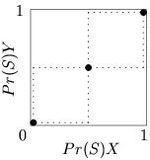Correspondence

Reaction correspondences , also known as best response correspondences, are used in the proof of the existence of mixed strategy Nash equilibria. [3] [4] Reaction correspondences are not "reaction functions" since functions must only have one value per argument, and many reaction correspondences will be undefined, i.e., a vertical line, for some opponent strategy choice. One constructs a correspondence b(·), for each player from the set of opponent strategy profiles into the set of the player's strategies. So, for any given set of opponent's strategies σ−i, bi(σ−i) represents player i's best responses to σ−i.

Response correspondences for all 2 × 2 normal form games can be drawn with a line for each player in a unit square strategy space. Figures 1 to 3 graphs the best response correspondences for the stag hunt game. The dotted line in Figure 1 shows the optimal probability that player Y plays 'Stag' (in the y-axis), as a function of the probability that player X plays Stag (shown in the x-axis). In Figure 2 the dotted line shows the optimal probability that player X plays 'Stag' (shown in the x-axis), as a function of the probability that player Y plays Stag (shown in the y-axis). Note that Figure 2 plots the independent and response variables in the opposite axes to those normally used, so that it may be superimposed onto the previous graph, to show the Nash equilibria at the points where the two player's best responses agree in Figure 3.
There are three distinctive reaction correspondence shapes, one for each of the three types of symmetric 2 × 2 games: coordination games, discoordination games, and games with dominated strategies (the trivial fourth case in which payoffs are always equal for both moves is not really a game theoretical problem). Any payoff symmetric 2 × 2 game will take one of these three forms.
Coordination games

Games in which players score highest when both players choose the same strategy, such as the stag hunt and battle of the sexes, are called coordination games. These games have reaction correspondences of the same shape as Figure 3, where there is one Nash equilibrium in the bottom left corner, another in the top right, and a mixing Nash somewhere along the diagonal between the other two.
Anti-coordination games

Games such as the game of chicken and hawk-dove game in which players score highest when they choose opposite strategies, i.e., discoordinate, are called anti-coordination games. They have reaction correspondences (Figure 4) that cross in the opposite direction to coordination games, with three Nash equilibria, one in each of the top left and bottom right corners, where one player chooses one strategy, the other player chooses the opposite strategy. The third Nash equilibrium is a mixed strategy which lies along the diagonal from the bottom left to top right corners. If the players do not know which one of them is which, then the mixed Nash is an evolutionarily stable strategy (ESS), as play is confined to the bottom left to top right diagonal line. Otherwise an uncorrelated asymmetry is said to exist, and the corner Nash equilibria are ESSes.
Games with dominated strategies

Games with dominated strategies have reaction correspondences which only cross at one point, which will be in either the bottom left, or top right corner in payoff symmetric 2 × 2 games. For instance, in the single-play prisoner's dilemma, the "Cooperate" move is not optimal for any probability of opponent Cooperation. Figure 5 shows the reaction correspondence for such a game, where the dimensions are "Probability play Cooperate", the Nash equilibrium is in the lower left corner where neither player plays Cooperate. If the dimensions were defined as "Probability play Defect", then both players best response curves would be 1 for all opponent strategy probabilities and the reaction correspondences would cross (and form a Nash equilibrium) at the top right corner.
Other (payoff asymmetric) games
A wider range of reaction correspondences shapes is possible in 2 × 2 games with payoff asymmetries. For each player there are five possible best response shapes, shown in Figure 6. From left to right these are: dominated strategy (always play 2), dominated strategy (always play 1), rising (play strategy 2 if probability that the other player plays 2 is above threshold), falling (play strategy 1 if probability that the other player plays 2 is above threshold), and indifferent (both strategies play equally well under all conditions).

While there are only four possible types of payoff symmetric 2 × 2 games (of which one is trivial), the five different best response curves per player allow for a larger number of payoff asymmetric game types. Many of these are not truly different from each other. The dimensions may be redefined (exchange names of strategies 1 and 2) to produce symmetrical games which are logically identical.
Matching pennies
One well-known game with payoff asymmetries is the matching pennies game. In this game one player, the row player (graphed on the y dimension) wins if the players coordinate (both choose heads or both choose tails) while the other player, the column player (shown in the x-axis) wins if the players discoordinate. Player Y's reaction correspondence is that of a coordination game, while that of player X is a discoordination game. The only Nash equilibrium is the combination of mixed strategies where both players independently choose heads and tails with probability 0.5 each.


